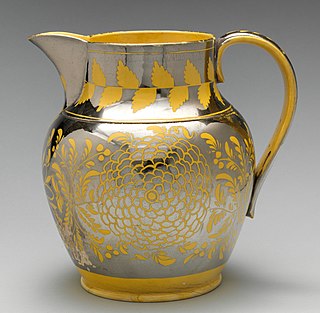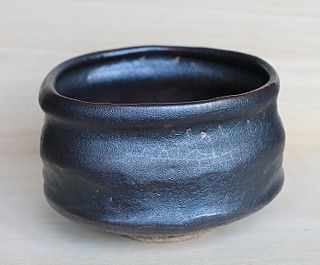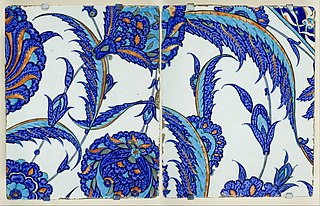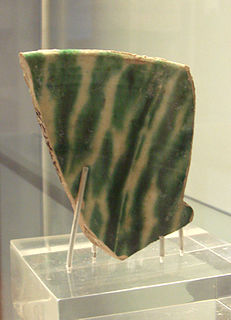
Islamic art encompasses the visual arts produced in the Islamic world. Islamic art is difficult to characterize because it covers a wide range of lands, periods, and genres, including Islamic architecture, Islamic calligraphy, Islamic miniature, Islamic glass, Islamic pottery, and textile arts such as carpets and embroidery. It comprises both religious and secular art forms. Religious art is represented by calligraphy, architecture and furnishings of religious buildings, such as mosque fittings, woodwork and carpets. Secular art also flourished in the Islamic world, although some of its elements were criticized by religious scholars.

Nishapur or Nishabur is a city in Razavi Khorasan Province, capital of the Nishapur County and former capital of Khorasan Province, in northeastern Iran, situated in a fertile plain at the foot of the Binalud Mountains. It had an estimated population of 264,180 as of 2016 and its county 448,125. Nearby are the turquoise mines that have supplied the world with turquoise for at least two millennia.

Pottery and porcelain, is one of the oldest Japanese crafts and art forms, dating back to the Neolithic period. Kilns have produced earthenware, pottery, stoneware, glazed pottery, glazed stoneware, porcelain, and blue-and-white ware. Japan has an exceptionally long and successful history of ceramic production. Earthenwares were created as early as the Jōmon period, giving Japan one of the oldest ceramic traditions in the world. Japan is further distinguished by the unusual esteem that ceramics holds within its artistic tradition, owing to the enduring popularity of the tea ceremony.

Celadon is a term for pottery denoting both wares glazed in the jade green celadon color, also known as greenware, and a type of transparent glaze, often with small cracks, that was first used on greenware, but later used on other porcelains. Celadon originated in China, though the term is purely European, and notable kilns such as the Longquan kiln in Zhejiang province are renowned for their celadon glazes. Celadon production later spread to other parts of East Asia, such as Japan and Korea as well as Southeast Asian countries such as Thailand. Eventually, European potteries produced some pieces, but it was never a major element there. Finer pieces are in porcelain, but both the color and the glaze can be produced in stoneware and earthenware. Most of the earlier Longquan celadon is on the border of stoneware and porcelain, meeting the Chinese but not the European definitions of porcelain.

Lustreware or Lusterware is a type of pottery or porcelain with a metallic glaze that gives the effect of iridescence. It is produced by metallic oxides in an overglaze finish, which is given a second firing at a lower temperature in a "muffle kiln", or a reduction kiln, excluding oxygen.

Medieval Islamic pottery occupied a geographical position between Chinese ceramics, the unchallenged leaders of Eurasian production, and the pottery of the Byzantine Empire and Europe. For most of the period it can fairly be said to have been between the two in terms of aesthetic achievement and influence as well, borrowing from China and exporting to and influencing Byzantium and Europe. The use of drinking and eating vessels in gold and silver, the ideal in ancient Rome and Persia as well as medieval Christian societies, is prohibited by the Hadiths, with the result that pottery and glass were used for tableware by Muslim elites, as pottery also was in China but was much rarer in Europe and Byzantium. In the same way, Islamic restrictions greatly discouraged figurative wall-painting, encouraging the architectural use of schemes of decorative and often geometrically-patterned titles, which are the most distinctive and original specialty of Islamic ceramics.

Swatow ware or Zhangzhou ware is a loose grouping of mainly late Ming dynasty Chinese export porcelain wares initially intended for the Southeast Asian market. The traditional name in the West arose because Swatow, or present-day Shantou, was the South Chinese port in Guangdong province from which the wares were thought to have been shipped. The many kilns were probably located all over the coastal region, but mostly near Zhangzhou, Pinghe County, Fujian, where several were excavated in the mid-1990s, which has clarified matters considerably.

Oribe ware is a style of Japanese pottery that first appeared in the sixteenth century. It is a type of Japanese stoneware recognized by its freely-applied glaze as well as its dramatic visual departure from the more somber, monochrome shapes and vessels common in Raku ware of the time. The ceramics were often asymmetrical, embracing the eccentricity of randomized shapes. Deformed shapes were not at all uncommon. These shapes were achieved through the implementation of moulding as a technique, as opposed to working on a potter’s wheel. Sometimes, bowls were so deformed that they became difficult to use – whisking tea could even become a difficult task.

Shino ware is Japanese pottery, usually stoneware, originally from Mino Province, in present-day Gifu Prefecture, Japan. It emerged in the 16th century, but the use of shino glaze is now widespread, both in Japan and abroad. It is identified by thick white glazes, red scorch marks, and a texture of small holes. Some experts believe it should not be treated as distinct from Oribe ware but described as "white Oribe", with the pottery usually called just Oribe described as "green Oribe" instead.

Chinese ceramics show a continuous development since pre-dynastic times and are one of the most significant forms of Chinese art and ceramics globally. The first pottery was made during the Palaeolithic era. Chinese ceramics range from construction materials such as bricks and tiles, to hand-built pottery vessels fired in bonfires or kilns, to the sophisticated Chinese porcelain wares made for the imperial court and for export. Porcelain was a Chinese invention and is so identified with China that it is still called "china" in everyday English usage.

Jun ware is a type of Chinese pottery, one of the Five Great Kilns of Song dynasty ceramics. Despite its fame, much about Jun ware remains unclear, and the subject of arguments among experts. Several different types of pottery are covered by the term, produced over several centuries and in several places, during the Northern Song dynasty (960–1127), Jin dynasty (1115–1234) and Yuan dynasty (1271–1368), and lasting into the early Ming dynasty (1368–1644).

Iznik pottery, or Iznik ware, named after the town of İznik in western Anatolia where it was made, is a decorated ceramic that was produced from the last quarter of the 15th century until the end of the 17th century.

Overglaze decoration, overglaze enamelling or on-glaze decoration is a method of decorating pottery, most often porcelain, where the coloured decoration is applied on top of the already fired and glazed surface, and then fixed in a second firing at a relatively low temperature, often in a muffle kiln. It is often described as producing "enamelled" decoration. The colours fuse on to the glaze, so the decoration becomes durable. This decorative firing is usually done at a lower temperature which allows for a more varied and vidid palette of colours, using pigments which will not colour correctly at the high temperature necessary to fire the porcelain body. Historically, a relatively narrow range of colours could be achieved with underglaze decoration, where the coloured pattern is applied before glazing, notably the cobalt blue of blue and white porcelain.

Fritware, also known as stone-paste, is a type of pottery in which frit is added to clay to reduce its fusion temperature. The mixture may include quartz or other siliceous material. An organic compound such as gum or glue may be added for binding. The resulting mixture can be fired at a lower temperature than clay alone. A glaze is then applied on the surface to harden the object.

Chinese influences on Islamic pottery cover a period starting from at least the 8th century CE to the 19th century. This influence of Chinese ceramics has to be viewed in the broader context of the considerable importance of Chinese culture on Islamic arts in general.

Cizhou ware or Tz'u-chou ware is a term for a wide range of Chinese ceramics from between the late Tang dynasty and the early Ming dynasty, but especially associated with the Northern Song to Yuan period in the 11–14th century. It has been increasingly realized that a very large number of sites in northern China produced these wares, and their decoration is very variable, but most characteristically uses black and white, in a variety of techniques. For this reason Cizhou-type is often preferred as a general term. All are stoneware in Western terms, and "high-fired" or porcelain in Chinese terms. They were less high-status than other types such as celadons and Jun ware, and are regarded as "popular", though many are finely and carefully decorated.

Persian pottery or Iranian pottery is the pottery made by the artists of Persia (Iran) and its history goes back to early Neolithic Age. Agriculture gave rise to the baking of clay, and the making of utensils by the people of Iran. Through the centuries, Persian potters have responded to the demands and changes brought by political turmoil by adopting and refining newly introduced forms and blending them into their own culture. This innovative attitude has survived through time and influenced many other cultures around the world.

Ceramic art is art made from ceramic materials, including clay. It may take forms including artistic pottery, including tableware, tiles, figurines and other sculpture. As one of the plastic arts, ceramic art is one of the visual arts. While some ceramics are considered fine art, as pottery or sculpture, most are considered to be decorative, industrial or applied art objects. Ceramics may also be considered artefacts in archaeology. Ceramic art can be made by one person or by a group of people. In a pottery or ceramic factory, a group of people design, manufacture and decorate the art ware. Products from a pottery are sometimes referred to as "art pottery". In a one-person pottery studio, ceramists or potters produce studio pottery.

Jizhou ware or Chi-chou ware is Chinese pottery from Jiangxi province in southern China; the Jizhou kilns made a number of different types of wares over the five centuries of production. The best known wares are simple shapes in stoneware, with a strong emphasis on subtle effects in the dark glazes, comparable to Jian ware, but often combined with other decorative effects. In the Song dynasty they achieved a high prestige, especially among Buddhist monks and in relation to tea-drinking. The wares often use leaves or paper cutouts to create resist patterns in the glaze, by leaving parts of the body untouched.

Mina'i ware is a type of Persian pottery developed in Kashan, Iran, in the decades leading up to the Mongol invasion of Persia in 1219, after which production ceased. It has been described as "probably the most luxurious of all types of ceramic ware produced in the eastern Islamic lands during the medieval period". The ceramic body of white-ish fritware or stonepaste is fully decorated with detailed paintings using several colours, usually including figures.






















